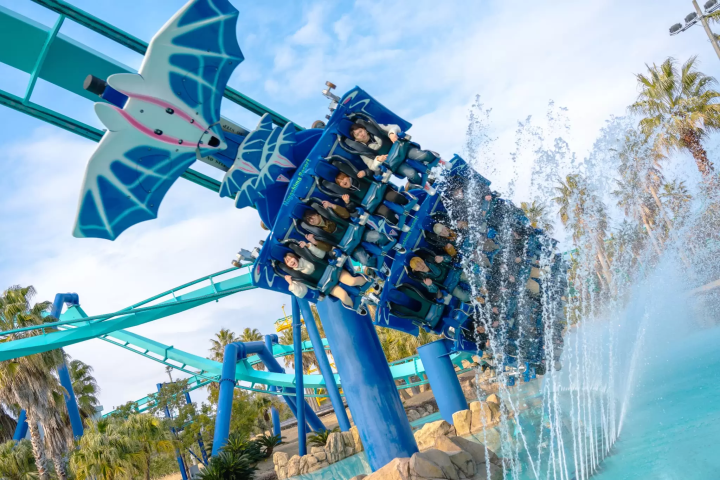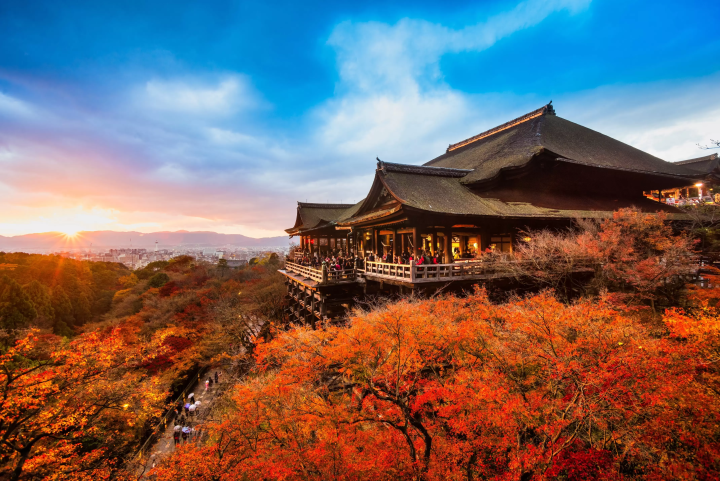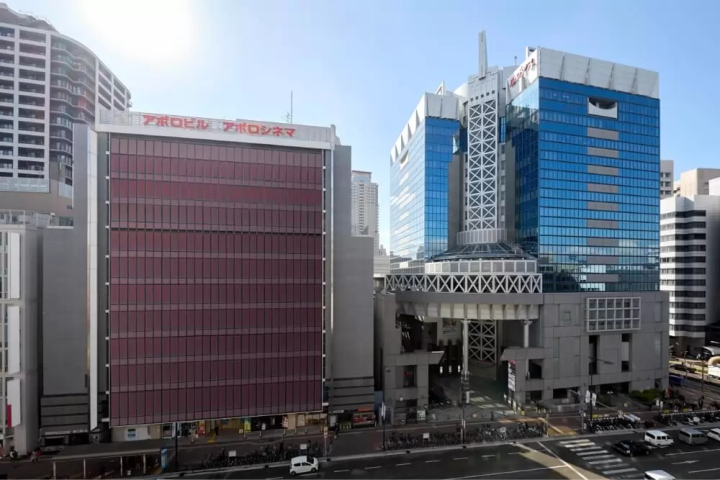Kenrokuen Garden: Features and History of Kanazawa's Most Scenic Spot

Kenrokuen Garden is the most famous place to visit in Kanazawa, with a history going back to the Edo period. Learn about Kenrokuen's history, seasonal highlights, access, and more. We also included information on nearby kimono rental shops!
Kenrokuen Garden: History and Seasonal Highlights
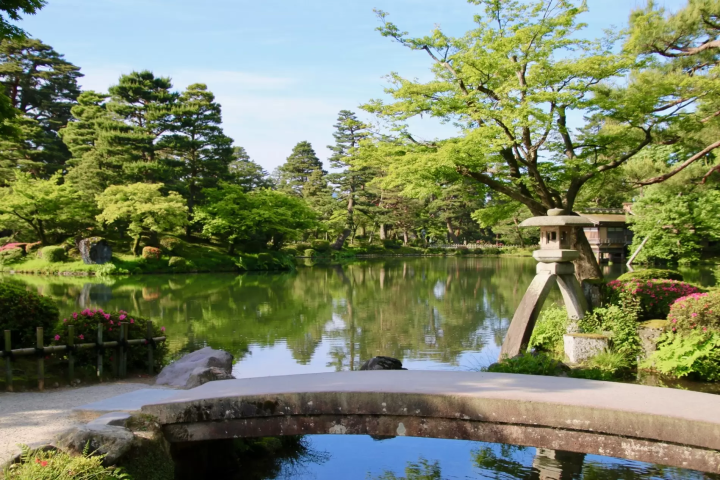
Photo by Pixta
If you visit Kenrokuen Garden in Kanazawa, known as one of Japan’s three most beautiful and famous gardens, researching its highlights and history beforehand will help you gain a deeper understanding and enhance your appreciation when you visit.
In this article, we’ll introduce Kenrokuen Garden’s seasonal highlights, provide information on how to get there and offer details on kimono rentals to make your visit even more enjoyable.
Kenrokuen Garden: Features and Highlights
1. Kenrokuen Garden: One of Japan's Three Famous Gardens
2. Kenrokuen Garden’s History
3. Kenrokuen Garden’s Highlights and Features
4. Hours and Admission Fee
5. Kenrokuen Garden Access
6. Parking
7. Kimono Rental Shops Near Kenrokuen Garden
Read also
Kenrokuen Garden: One of Three Famous Gardens

Photo by Pixta
Kenrokuen Garden is one of Japan’s most renowned gardens, located in Kanazawa, Ishikawa Prefecture. It is widely recognized as one of Japan’s top three famous and outstanding gardens, along with Kairakuen Garden in Mito, Ibaraki Prefecture, and Korakuen Garden in Okayama, Okayama Prefecture.
The garden is located near central Kanazawa, a city rich in sightseeing spots and hot springs, making it a hub for Hokuriku sightseeing.
Kenrokuen is a kaiyu-style garden (a type of promenade garden centered around a pond) set in a vast area that features a pond, artificial hills, and a teahouse. Visitors can enjoy various landscapes, including waterfalls with varying elevations, cherry blossoms, pine trees, seasonal flowers, lanterns, stone monuments, and Japan’s oldest fountain.
There are spots throughout the garden where you can take a break, such as the pavilion and teahouse. From the observation deck, you can enjoy views of the Kaga Plain, Uchinada Sand Dunes, Noto Peninsula, and the Sea of Japan.
Kenrokuen Garden’s History
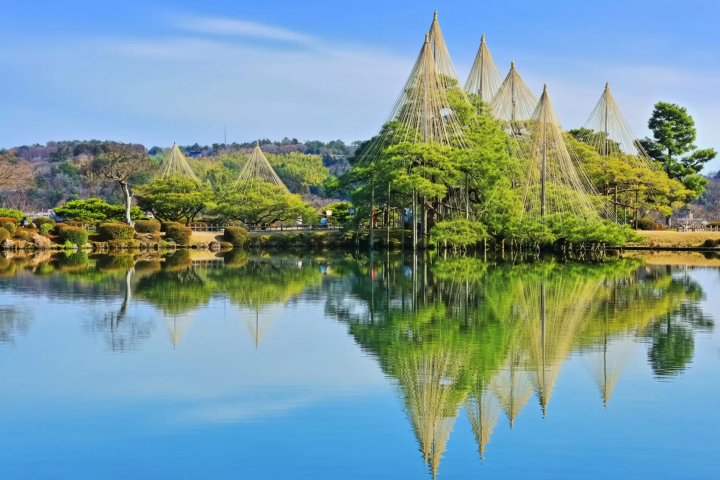
Photo by Pixta
It all began in 1676 when Tsunanori Maeda, the fifth lord of the Kaga Domain, built a lotus pond garden around his villa. Over time, the garden was continually modified as new lords took over and underwent significant changes in its shape and design.
The garden was officially named Kenrokuen Garden during the time when Narinaga Maeda was the twelfth lord of the Kaga Domain. It took on its current form during the time of Nariyasu Maeda, the thirteenth lord, who expanded the pond and planted well-shaped trees.
The garden opened to the general public in 1874, then became a National Place of Scenic Beauty in 1922. In 1985, it was further promoted to a Special Place of Scenic Beauty, then received the highest designation possible when it became a National Treasure Garden.
The name “Kenrokuen” comes from its possession of the six views or qualities described in the “Records of Famous Gardens in Luoyang,” a text from the Song Dynasty. These qualities are spaciousness, seclusion, artifice, antiquity, watercourses, and panoramic views. In 2024, the garden celebrated its 150th anniversary since its opening.
Kenrokuen Garden’s Highlights and Features
Kenrokuen Garden provides opportunities to experience changes in scenery throughout its various areas, showcasing significant transformations with each season. Next, we’ll introduce the highlights and features of Kenrokuen Garden, which can be enjoyed in all four seasons.
Spring: Kenrokuen Kikuzakura
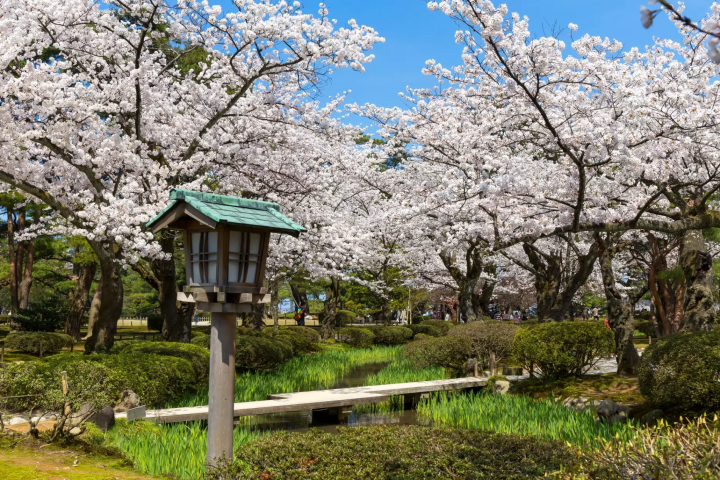
Photo by Pixta
The beauty of the cherry blossoms in spring is truly indescribable. During this season, the garden, which is about 2.4 times the size of Tokyo Dome, is completely blanketed in pink. The garden features about 400 cherry trees of 40 varieties, with the Yoshino cherry being the main type, as well as rare varieties like the Kenrokuen kikuzakura (chrysanthemum cherry) and Kenrokuen kumagai.
Of these varieties, Kenrokuen kikuzakura is distinguished by its large flowers, each featuring between 200 to 300 overlapping petals. This variety is popular for its chrysanthemum-like appearance. The flowers bloom from late April to early May. They start as a deep ruby red in the bud stage, gradually changing to a light pink from the center outward, and finally to white.
During the peak cherry blossom season, the garden is illuminated at night, creating a magical atmosphere. Being able to see this sight is a privilege reserved for those who visit in the spring.
Summer: Fresh Green Foliage
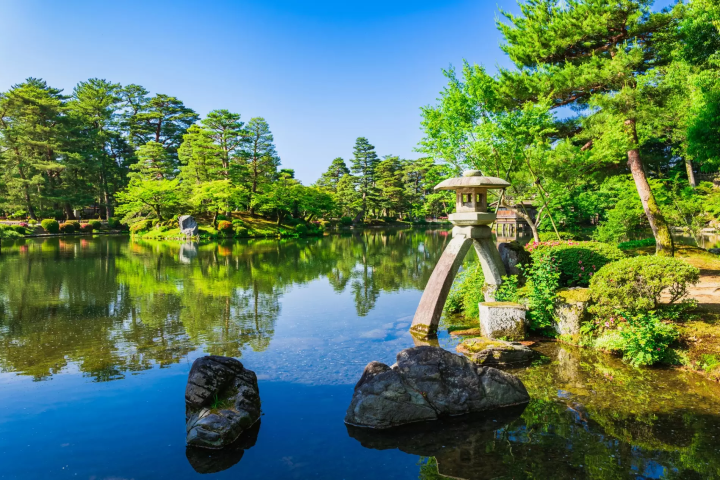
Photo by Pixta
A variety of flowers continue to add color to the vivid greens of summer. In early summer, bright pink azaleas and elegant purple Japanese irises bloom in full splendor. The deepening greens of the trees and grass create a magnificent contrast with the beautiful colors of the flowers.
The Japanese irises that bloom along the winding streams are especially worth the visit. A walk around the pond, winding streams, and fountain to cool off will also leave you feeling refreshed. In early June, when the Hyakumangoku Festival is held, an event called “The Four Seasons of Kanazawa Castle and Kenrokuen Garden: Early Summer Illuminations” will also take place.
During the festival, admission to Kenrokuen Garden is free, and you can enjoy a nighttime stroll through the grounds. In the evening, gagaku (traditional court music) is performed on boats in the ponds, creating a wondrous and elegant atmosphere distinct from the daytime.
Autumn: Fall Foliage
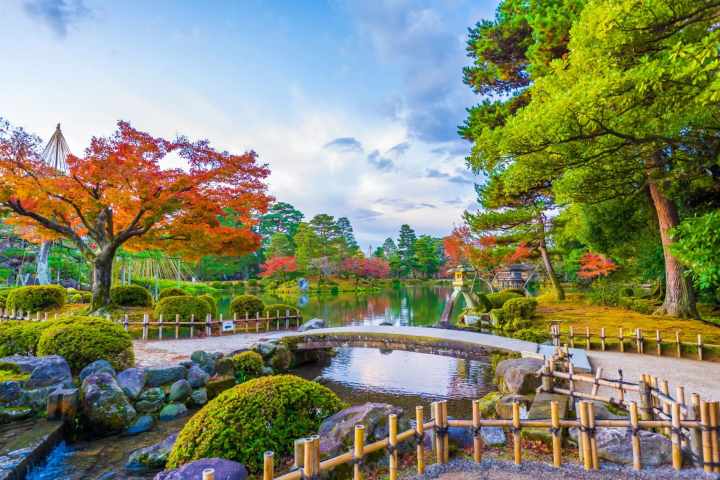
Photo by Pixta
As autumn arrives, the leaves turn a beautiful red and gold, making the change of seasons even more perceivable. The garden boasts around 400 cherry trees, 340 maples, and 50 zelkova trees that contribute to the fall foliage. No matter where you take your pictures, you’ll capture beauty that seems straight out of a painting.
Green trees gradually begin to change color around October, with the peak time for viewing the autumn leaves in November. During this season, "The Four Seasons of Kanazawa Castle and Kenrokuen Garden: Autumn Illuminations" takes place. The illuminated autumn leaves create a stunning contrast with the green pine trees, offering a magical atmosphere that is completely different from the early summer.
Winter: Yukizuri
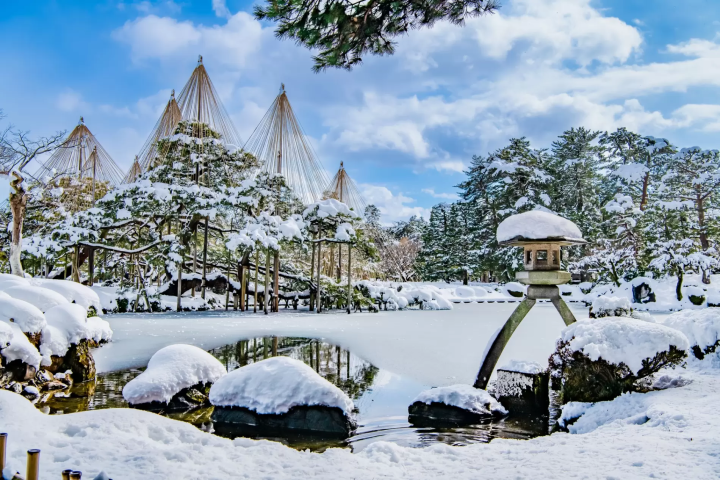
Photo by Pixta
One of Kenrokuen Garden’s winter highlights is yukizuri, a traditional method of winterizing trees. This method protects the branches from breaking under the weight of heavy snow, which accumulates due to moisture. Yukizuri involves a gardener climbing a central pole, up to 14 meters high, and securing several ropes in a conical shape from the top to the branches.
The yukizuri preparation typically begins in early November. The completed displays, seen in approximately 800 areas throughout the garden, have become synonymous with winter in Kanazawa. From a distance, the trees appear to be wrapped in cone-shaped veils. Remarkably, the total weight of the ropes used for this process equals to around four tons.
The setup for yukizuri continues until mid-December, then remains in place until mid-March of the following year. After this period, the removal process begins.
Hours and Admission Fee
Kenrokuen Garden is open year-round, but hours will vary by season and events. From March 1 to October 15, the hours are 7:00 - 18:00 (last entry at 17:30). From October 16 to the end of February, the hours are 8:00 - 17:00 (last entry at 16:30).
Admission fees are 320 yen for adults (18 years and older), 100 yen for children (ages 6 to 17), and free for seniors ages 65 and older (must present a photo ID) (as of July 4, 2024).
Kenrokuen Garden Access
As mentioned earlier, the garden is located near central Kanazawa, making it easily accessible. Below, we introduce how to reach the garden by car or public transportation (train/bus).
Access by Car
If driving, the estimated travel times from nearby interchanges are as follows.
- 30 minutes from the Kanazawa-Nishi IC on the Hokuriku Expressway
- 30 minutes from the Kanazawa-Higashi IC on the Hokuriku Expressway
- 20 minutes from the Kanazawa-Morimoto IC on the Hokuriku Expressway
You may encounter heavy traffic when driving through the city center depending on the time of day.
Access by Train and Bus
Take the Hokuriku Shinkansen from Tokyo, the Limited Express Thunderbird from Kansai, or the Limited Express Shirasagi from the Tokai region, and alight at JR Kanazawa Station. The most convenient option is to board the Kanazawa Loop Bus from bus stop #6 at the bus terminal by the JR Kanazawa Station Kenrokuen Exit (former East Exit).
Hokuriku Railroad operates buses every 15 minutes from 8:30 to 18:05 daily, with both a right loop bus and a left loop bus. For the fastest route to Kenrokuen Garden, take the right loop bus. To go directly to Kenrokuen Garden without any stops, alight at bus stop #6 Kenrokuen Garden and Kanazawa Castle Park (Ishikawamon-mukai). The entrance to Katsurazaka Gate (tollgate) is just a short walk away.
Parking
If you are driving, the Kenroku Parking Lot or Ishibiki Parking Lot are convenient options.
1. Kenroku Parking Lot
The Kenroku Parking Lot, located at 1-53 Koshomachi, Kanazawa, is a five-story indoor parking garage. It is conveniently situated just a three-minute walk from Kenrokuen Garden and offers excellent access to other popular sightseeing destinations. The first floor has space for up to 40 sightseeing buses or microbuses, while floors 2 through 5 provide parking for 480 standard-sized vehicles.
The parking lot is open 24 hours a day year-round and is a clean facility with a break area, sightseeing information center, EV chargers, and vending machines. Parking fees are 350 yen for the first hour, then 150 yen for every additional 30 minutes. Payments can be made with cash, credit card, digital currency, or mobile payment.
2. Ishibiki Parking Lot
Ishibiki Parking Lot, located at 4-380 Ishibiki, Kanazawa, is an outdoor surface parking lot about five minutes on foot from Kenrokuen Garden. It accommodates up to 403 standard-sized vehicles and three microbuses or campervans. This parking lot is also open 24 hours a day, year-round. Parking fees are 100 yen for every 30 minutes up to the first hour, then an additional 100 yen for every 60 minutes thereafter.
While Ishibiki Parking Lot is more cost-effective when parking for several hours compared to Kenroku Parking Lot, it may become full if there’s an event. You can check the current status of both parking lots online to see if there are available spaces or if they are full. You can check the current status of both parking lots online to see if there are available spaces or if they are full.
Kimono Rental Shops Near Kenrokuen Garden
Make your visit even more exciting by strolling through the historic streets of Kanazawa, including Kenrokuen Garden, dressed in a kimono.
There are several kimono rental shops near Kenrokuen Garden, so be sure to give them a try. In this section, we introduce some popular shops known for their extensive selection.
Kanazawa Kimono Karen
Kanazawa Kimono Karen is a kimono rental shop located right next to Kenrokuen Garden. It boasts the largest selection of kimonos in Kanazawa, with a collection of 1,300 kimonos.
Enjoy kimonos in a variety of designs in retro, modern, and antique styles gathered from across Japan. The entire wall is lined with kimonos, obis, and other accessories, making the shop look like a museum.
There is a free space inside where you can style your own hair and makeup. There are five dressing tables, along with hair accessories and flat irons available for your use.
Official Website: https://www.kimono-karen.jp/ (Japanese)
Kimono Rental VASARA
Kimono Rental VASARA Kanazawa Kenrokuen is a kimono rental shop located just a minute away from the entrance to Kenrokuen Garden. Based around the concept of effortless beauty, the shop also has locations in Asakusa and Kyoto, and is popular among young people and international visitors.
The basic plan starts at 3,000 yen, making it an attractive and affordable price.
Enjoy Seasonal Landscapes at Kenrokuen Garden
Kenrokuen Garden, one of Japan’s three most famous gardens, is a must-visit sightseeing spot when visiting Kanazawa. This garden will captivate your heart with everything it offers, from its landscapes and buildings to the trees and flowers.
Take a walk around the well-maintained kaiyu-style garden and experience the six qualities—spaciousness, seclusion, artifice, antiquity, watercourses, and panoramic views—that inspired the name Kenrokuen Garden.
Read also
Main image by Pixta
Written by Kakutama editorial team
This is the official account of MATCHA's editorial department. Our articles feature useful travel information for visitors to Japan, from how-to guides to recommended places to visit.




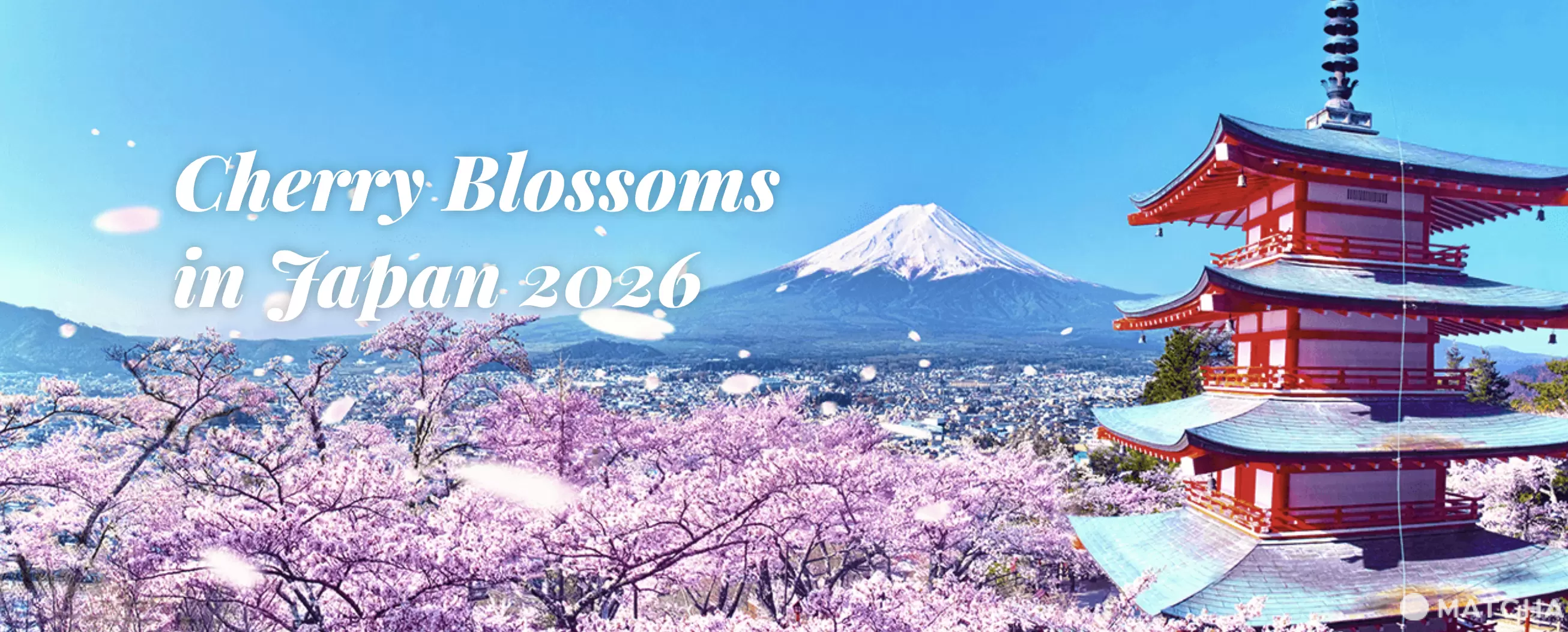


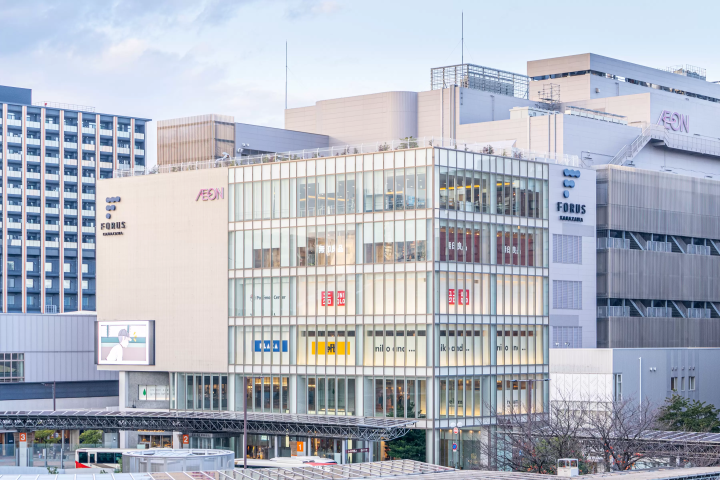

























![[Close to Chubu Centrair International Airport] Tokoname's beloved "town milk"](https://resources.matcha-jp.com/resize/720x2000/2026/01/13-255409.webp)

